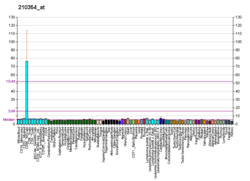
Back إنترفيرون غاما Arabic اینترفرون قاما AZB Interferó gamma Catalan Interferon γ Czech IFNG Welsh Interferon-γ German Interferón gamma Spanish اینترفرون گاما Persian Interféron gamma French Interferón gamma Galician
| Interferon gamma | |||||||||
|---|---|---|---|---|---|---|---|---|---|
 Crystal structure of a biologically active single chain mutant of human interferon gamma | |||||||||
| Identifiers | |||||||||
| Symbol | IFN gamma | ||||||||
| Pfam | PF00714 | ||||||||
| Pfam clan | CL0053 | ||||||||
| InterPro | IPR002069 | ||||||||
| SCOP2 | 1rfb / SCOPe / SUPFAM | ||||||||
| |||||||||
| Clinical data | |
|---|---|
| Trade names | Actimmune |
| AHFS/Drugs.com | Monograph |
| MedlinePlus | a601152 |
| ATC code | |
| Identifiers | |
| |
| CAS Number | |
| DrugBank | |
| ChemSpider |
|
| UNII | |
| ChEMBL | |
| Chemical and physical data | |
| Formula | C761H1206N214O225S6 |
| Molar mass | 17145.65 g·mol−1 |
| | |
Interferon gamma (IFNG or IFN-γ) is a dimerized soluble cytokine that is the only member of the type II class of interferons.[5] The existence of this interferon, which early in its history was known as immune interferon, was described by E. F. Wheelock as a product of human leukocytes stimulated with phytohemagglutinin, and by others as a product of antigen-stimulated lymphocytes.[6] It was also shown to be produced in human lymphocytes.[7] or tuberculin-sensitized mouse peritoneal lymphocytes[8] challenged with Mantoux test (PPD); the resulting supernatants were shown to inhibit growth of vesicular stomatitis virus. Those reports also contained the basic observation underlying the now widely employed interferon gamma release assay used to test for tuberculosis. In humans, the IFNG protein is encoded by the IFNG gene.[9][10]
Through cell signaling, interferon gamma plays a role in regulating the immune response of its target cell.[11] A key signaling pathway that is activated by type II IFN is the JAK-STAT signaling pathway.[12] IFNG plays an important role in both innate and adaptive immunity. Type II IFN is primarily secreted by CD4+ T helper 1 (Th1) cells, natural killer (NK) cells, and CD8+ cytotoxic T cells. The expression of type II IFN is upregulated and downregulated by cytokines.[13] By activating signaling pathways in cells such as macrophages, B cells, and CD8+ cytotoxic T cells, it is able to promote inflammation, antiviral or antibacterial activity, and cell proliferation and differentiation.[14] Type II IFN is serologically different from interferon type 1, binds to different receptors, and is encoded by a separate chromosomal locus.[15] Type II IFN has played a role in the development of cancer immunotherapy treatments due to its ability to prevent tumor growth.[13]
- ^ a b c GRCh38: Ensembl release 89: ENSG00000111537 – Ensembl, May 2017
- ^ a b c GRCm38: Ensembl release 89: ENSMUSG00000055170 – Ensembl, May 2017
- ^ "Human PubMed Reference:". National Center for Biotechnology Information, U.S. National Library of Medicine.
- ^ "Mouse PubMed Reference:". National Center for Biotechnology Information, U.S. National Library of Medicine.
- ^ Gray PW, Goeddel DV (August 1982). "Structure of the human immune interferon gene". Nature. 298 (5877): 859–863. Bibcode:1982Natur.298..859G. doi:10.1038/298859a0. PMID 6180322. S2CID 4275528.
- ^ Wheelock EF (July 1965). "Interferon-Like Virus-Inhibitor Induced in Human Leukocytes by Phytohemagglutinin". Science. 149 (3681): 310–311. Bibcode:1965Sci...149..310W. doi:10.1126/science.149.3681.310. PMID 17838106. S2CID 1366348.
- ^ Green JA, Cooperband SR, Kibrick S (June 1969). "Immune specific induction of interferon production in cultures of human blood lymphocytes". Science. 164 (3886): 1415–1417. Bibcode:1969Sci...164.1415G. doi:10.1126/science.164.3886.1415. PMID 5783715. S2CID 32651832.
- ^ Milstone LM, Waksman BH (November 1970). "Release of virus inhibitor from tuberculin-sensitized peritoneal cells stimulated by antigen". Journal of Immunology. 105 (5): 1068–1071. doi:10.4049/jimmunol.105.5.1068. PMID 4321289. S2CID 29861335.
- ^ Naylor SL, Sakaguchi AY, Shows TB, Law ML, Goeddel DV, Gray PW (March 1983). "Human immune interferon gene is located on chromosome 12". The Journal of Experimental Medicine. 157 (3): 1020–1027. doi:10.1084/jem.157.3.1020. PMC 2186972. PMID 6403645.
- ^ "Entrez Gene: IFNGR2".
- ^ Cite error: The named reference
:0was invoked but never defined (see the help page). - ^ Cite error: The named reference
:03was invoked but never defined (see the help page). - ^ a b Cite error: The named reference
:2was invoked but never defined (see the help page). - ^ Cite error: The named reference
:1was invoked but never defined (see the help page). - ^ Lee AJ, Ashkar AA (2018). "The Dual Nature of Type I and Type II Interferons". Frontiers in Immunology. 9: 2061. doi:10.3389/fimmu.2018.02061. PMC 6141705. PMID 30254639.
© MMXXIII Rich X Search. We shall prevail. All rights reserved. Rich X Search





